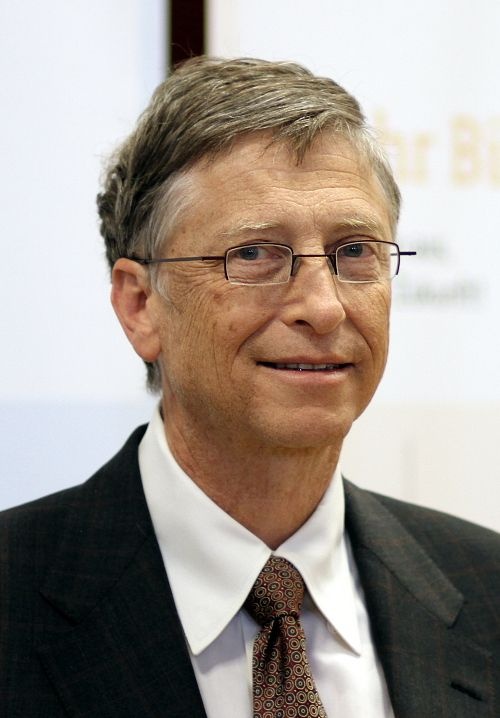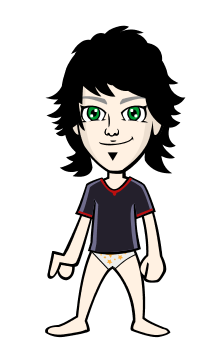William Henry "Bill" Gates III (born October 28, 1955) is an American business magnate, philanthropist, investor, and computer programmer.[2][3] In 1975, Gates andPaul Allen co-founded Microsoft, which became the world's largest PC software company. During his career at Microsoft, Gates held the positions of chairman, CEO andchief software architect, and was the largest individual shareholder until May 2014.[4][a] Gates has authored and co-authored several books.
Starting in 1987, Gates was included in the Forbes list of the world's wealthiest people[7] and was the wealthiest from 1995 to 2007, again in 2009, and has been since 2014.[8] Between 2009 and 2014, his wealth doubled from US$40 billion to more than US$82 billion.[9] Between 2013 and 2014, his wealth increased by US$15 billion.[10]Gates is currently the wealthiest person in the world with a wealth of US$77.2 billion.[11]
Gates is one of the best-known entrepreneurs of the personal computer revolution. Gates has been criticized for his business tactics, which have been considered anti-competitive, an opinion which has in some cases been upheld by numerous court rulings.[12][13] Later in his career Gates pursued a number of philanthropic endeavors, donating large amounts of money to various charitable organizations and scientific research programs through the Bill & Melinda Gates Foundation, established in 2000.
Early life
Gates was born in Seattle, Washington on October 28, 1955. He is the son of William H. Gates, Sr.[b] and Mary Maxwell Gates. Gates' ancestral origin includes English, German, and Irish, Scots-Irish.[18][19] His father was a prominent lawyer, and his mother served on the board of directors for First Interstate BancSystem and the United Way. Gates's maternal grandfather was JW Maxwell, a national bank president. Gates has one elder sister, Kristi (Kristianne), and one younger sister, Libby. He was the fourth of his name in his family, but was known as William Gates III or "Trey" because his father had the "II" suffix.[20] Early on in his life, Gates's parents had a law career in mind for him.[21] When Gates was young, his family regularly attended a Protestant Congregational church.[22][23][24] The family encouraged competition; one visitor reported that "it didn't matter whether it was hearts or pickleball or swimming to the dock ... there was always a reward for winning and there was always a penalty for losing".[25]
At 13, he enrolled in the Lakeside School, a private preparatory school.[26] When he was in the eighth grade, the Mothers Club at the school used proceeds from Lakeside School's rummage sale to buy a Teletype Model 33 ASR terminal and a block of computer time on a General Electric (GE) computer for the school's students.[27] Gates took an interest in programming the GE system in BASIC, and was excused from math classes to pursue his interest. He wrote his first computer program on this machine: an implementation of tic-tac-toe that allowed users to play games against the computer. Gates was fascinated by the machine and how it would always execute software code perfectly. When he reflected back on that moment, he said, "There was just something neat about the machine."[28] After the Mothers Club donation was exhausted, he and other students sought time on systems including DEC PDP minicomputers. One of these systems was a PDP-10 belonging to Computer Center Corporation (CCC), which banned four Lakeside students – Gates,Paul Allen, Ric Weiland, and Kent Evans – for the summer after it caught them exploiting bugs in the operating system to obtain free computer time
Microsoft
Main articles: History of Microsoft and Microsoft
BASIC
MITS Altair 8800 Computer with 8-inch (200 mm) floppy disk system
After reading the January 1975 issue of Popular Electronics that demonstrated the Altair 8800, Gates contacted Micro Instrumentation and Telemetry Systems (MITS), the creators of the new microcomputer, to inform them that he and others were working on a BASIC interpreter for the platform.[44] In reality, Gates and Allen did not have an Altair and had not written code for it; they merely wanted to gauge MITS's interest. MITS president Ed Roberts agreed to meet them for a demo, and over the course of a few weeks they developed an Altair emulator that ran on a minicomputer, and then the BASIC interpreter. The demonstration, held at MITS's offices in Albuquerque, was a success and resulted in a deal with MITS to distribute the interpreter as Altair BASIC. Paul Allen was hired into MITS,[45] and Gates took a leave of absence from Harvard to work with Allen at MITS in Albuquerque in November 1975. They named their partnership "Micro-Soft" and had their first office located in Albuquerque.[45] Within a year, the hyphen was dropped, and on November 26, 1976, the trade name "Microsoft" was registered with the Office of the Secretary of the State of New Mexico.[45] Gates never returned to Harvard to complete his studies.
Microsoft's Altair BASIC was popular with computer hobbyists, but Gates discovered that a pre-market copy had leaked into the community and was being widely copied and distributed. In February 1976, Gates wrote an Open Letter to Hobbyists in the MITS newsletter in which he asserted that more than 90% of the users of Microsoft Altair BASIC had not paid Microsoft for it and by doing so the Altair "hobby market" was in danger of eliminating the incentive for any professional developers to produce, distribute, and maintain high-quality software.[46] This letter was unpopular with many computer hobbyists, but Gates persisted in his belief that software developers should be able to demand payment. Microsoft became independent of MITS in late 1976, and it continued to develop programming language software for various systems.[45] The company moved from Albuquerque to its new home inBellevue, Washington, on January 1, 1979.[44]
During Microsoft's early years, all employees had broad responsibility for the company's business. Gates oversaw the business details, but continued to write code as well. In the first five years, Gates personally reviewed every line of code the company shipped, and often rewrote parts of it as he saw fit.
Windows
Microsoft launched its first retail version of Microsoft Windows on November 20, 1985, and in August, the company struck a deal with IBM to develop a separate operating system called OS/2. Although the two companies successfully developed the first version of the new system, mounting creative differences caused the partnership to deteriorate
Personal
Gates's wife suggested people should emulate the philanthropic efforts of the Salwen family, which had sold its home and given away half of its value, as detailed in The Power of Half.[100] Gates and his wife invited Joan Salwen to Seattle to speak about what the family had done, and on December 9, 2010, Gates, investor Warren Buffett, and Facebook founder and CEO Mark Zuckerberg signed a commitment they called the "Gates-Buffet Giving Pledge." The pledge is a commitment by all three to donate at least half of their wealth over the course of time to charity.




